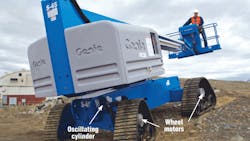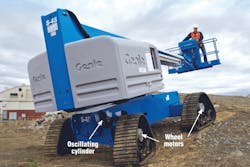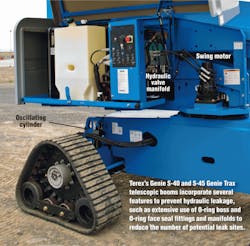Hydraulics keeps track boom on even ground
New Genie S-40 Trax and S-45 Trax telescopic booms, from Terex Aerial Work Platforms, Redmond, Wash., are now available with the company’s four-point Trax track drive system. By using four triangular track drives instead of wheels, the machines are better equipped to tackle uneven terrain, especially under a wide variety of soil conditions. And unlike full-length track drives on skid-steer machines, the triangular track drives cause less damage to sensitive ground surfaces, making the S-40 and S-45 able to take on almost any surface.
Powerful, yet gentle
Furthermore, both machines also use Terex’s active oscillating axles, which use a pair of hydraulic cylinders to keep tracks in contact with the ground on uneven and undulating surfaces within the stroke limit of the cylinders. This feature ensures that the vehicles maintain maximum traction, power, and torque.
Frank Schneider, Senior Product Manager, Terex Aerial Work Platforms, explained, “The four-point track system allows the tracks to drive softer over sensitive surfaces while also reducing the platform movement. This is a superior product for specific geographies, such as the Southern United States and Northern Europe, where soil and site conditions require specialized pieces of equipment.”
Because the tracks are encased in rubber, they do less damage to sensitive ground surfaces, such as turf, while still remaining rigid. Reduced ground pressure provides a high level of flotation in terrains such as sand, mud, and compact snow.
Attention to detail
The Genie Trax booms offer traditional front wheel steering, with a 30° steer angle. By driving and steering like a wheeled machine, each triangular shaped track can swivel 22° up and down to easily follow undulating terrain and sharp changes in slope, such as the break-over angle found on many transport trailers. Furthermore, their narrow chassis and front wheel steering allow the Trax booms to fit into narrow locations and tight job sites with ease.
The Trax booms share a common chassis with the standard wheeled Genie S-40 and S-45 machines, resulting in service parts commonality. The common platform also limits the amount of service training for technicians who work on both types of machines. With a maximum drive speed of 2.5 mph, units are able to get around job sites quickly.
High-quality hydraulics
According to Mike Kehler, P. E., Engineering Manager, Boom Engineering, Aerial Work Platforms, at Terex’s Moses Lake, Wash. facility, propulsion for both models is provided by a hydrostatic drive provided by Sauer-Danfoss. A hydraulic motor drives each track through a wheel drive.
Kehler said the swing drive is also powered by a hydraulic motor. The S-40 and S-45 both use a single cylinder to extend the boom. Larger machines may be done with either multiple cylinders or with extend/retract cable system to multiply the cylinder stroke.
Kehler explained that the work basket of both models is kept level using a master cylinder and slave cylinders; levelling can also be accomplished manually. All other functions are electric over hydraulic; some from a control system, some hard wired depending on the machine.
Kehler continued, “A load sense valve conserves energy by keeping system pressure around 200 psi when functions are not being activated. Other machines have different size pumps and a few use pressure compensation pumps for functions.”
And to hold leakage at bay, Kehler said all hydraulic fittings have an O-ring boss interface and all hose assemblies use O-ring face seals. “Preventing hoses from getting tangled is always a work in progress. Newer machines are trending to hard lines to have specific routing paths and minimize the hose routing impact on assembly.”
For more information on Terex telescopic booms or other equipment, visit www.terex.com.



